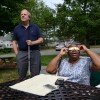It’s the final night of Hanukkah, the eight-day annual religious rededication marked by Jews the world over. Tonight, along with an exchange of gifts and special foods, the faithful will remember the miracle of the oil Judah of the Maccabees carried into the Holy Temple. Oil only enough for one day, but which wondrously kept the flames lit for eight. This year’s Hanukkah celebration took on special meaning at Pittsburgh’s Tree of Life Synagogue. Where 11 were murdered less than two months ago, hundreds gathered for the first night of the celebration. Rabbi Jonathan Perlman spoke of the still visceral pain and the ongoing healing. But, he reminded those gathered, “There is never a time without hope.”
I admire Rabbi Perlman’s spiritual confidence, but I can’t stop thinking about what drove the madman to kill the temple members, and about how this year’s festival of lights is happening against a backdrop of the ever-increasing rise of anti-Semitism. It’s always been there, of course, but for a lot of my life, the people spewing the nastiness were spurned. Now bold acts of hate occur routinely. Two Sundays ago, on the first day of Hanukkah, a man riding his bicycle along the Cambridge Common got off his bike and pushed over the large menorah placed there for a later public lighting ceremony. Not only did he do it in the broad daylight, but startled witnesses watched the unnamed vandal finish his intentional act and then calmly get back on his bike and ride away. This follows a series of recent swastika sightings throughout the state’s area schools — three swastikas in a Jewish teacher’s classroom in October, drawings of three Nazi symbols found in the boys’ bathroom at Boxford High in mid-November, and more at UMass Amherst, accompanied by homophobic and racist slurs. Swastikas were also found on the science lab bench at Reading High School, where the school and the town have been battling anti-Semitic graffiti for more than a year.
For a long time, I regarded the hate groups lurking on the dark web as outliers whose influence was limited. But, Charlottesville, with the torch-carrying Neo brown shirts, shouting “the Jews will not replace us,” revealed the depth of the religious animus. The FBI documents a 37 percent rise in hate crimes against Jews; black citizens are the next biggest target. And yet, I don’t think most of us have grasped the intensity of the hate fueling these crimes, or that the targeted venom seems to be embraced by young people. White supremacist groups are successfully recruiting on college campuses. Prom-going Wisconsin high schoolers gleefully pose giving a Nazi salute. In April, a survey found that 22 percent of millennials have either never heard of the Holocaust or didn’t recognize the name of a concentration camp.
Several avowed white supremacists were elected to national office a few weeks ago. A lot of Americans put them there, and frankly, that scares me. I’ve got to believe that more people are resisting the hate, like the group of Cambridge bystanders who saw the attempted destruction of the menorah and spontaneously came together to prop it up in time for the evening’s ceremony. If there ever was a time for all of us to push back the forces of hate, it’s now. No better time to recommit than tonight as the last candle on the menorah is lit. I’ll begin by recalling the joyous words of the Hebrew children’s song, “We’ve come to drive out darkness.” “Each of us is one small light,” the song goes. “All together we shine bright.”





